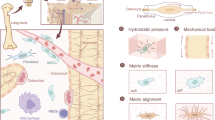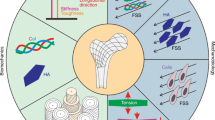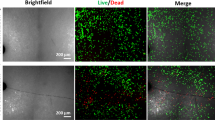Abstract
The architecture of trabecular bone, the porous bone found in the spine and at articulating joints, provides the requirements for optimal load transfer, by pairing suitable strength and stiffness to minimal weight according to rules of mathematical design1,2,3,4,5,6. But, as it is unlikely that the architecture is fully pre-programmed in the genes7, how are the bone cells informed about these rules, which so obviously dictate architecture? A relationship exists between bone architecture and mechanical usage8—while strenuous exercise increases bone mass9, disuse, as in microgravity and inactivity, reduces it10. Bone resorption cells (osteoclasts) and bone formation cells (osteoblasts) normally balance bone mass in a coupled homeostatic process of remodelling, which renews some 25% of trabecular bone volume per year. Here we present a computational model of the metabolic process in bone that confirms that cell coupling is governed by feedback from mechanical load transfer11,12,13.This model can explain the emergence and maintenance of trabecular architecture as an optimal mechanical structure, as well as its adaptation to alternative external loads.
This is a preview of subscription content, access via your institution
Access options
Subscribe to this journal
Receive 51 print issues and online access
$199.00 per year
only $3.90 per issue
Buy this article
- Purchase on Springer Link
- Instant access to full article PDF
Prices may be subject to local taxes which are calculated during checkout




Similar content being viewed by others
References
Wolff, J. Das Gesetz der Transformation der Knochen (Hirchwild, Berlin, 1892); translated as The Law of Bone Remodeling (trans. Maquet, P. & Furlong, R.) (Springer, Berlin, 1986).
Thompson, D. W. On Growth and Form (Cambridge Univ. Press Cambridge, 1919).
Roesler, H. The history of some fundamental concepts in bone biomechanics. J. Biomechanics 20, 1025–1034 (1987).
Cowin, S. C. Wollff's law of trabecular bone architecture at remodeling equilibrium. J. Biomech. Engr. 108, 83–88 (1986).
Carter, D. R., Fyhrie D. P. & Whalen R. T. Trabecular bone density and loading history: Regulation of connective tissue biology by mechanical energy. J. Biomechanics 20, 785–794 (1987).
Mullender, M. G. & Huiskes, R. A proposal for the regulatory mechanism of Wolff's law. J. Orthop. Res. 13, 503–512 (1995).
Stewart, I. Life's Other Secret (Allen Lane/Penguin, London, 1998).
Lanyon, L. E. Using functional loading to influence bone mass and architecture: objectives, mechanisms and relationship with estrogen of the mechanically adaptive process in bone. Bone 18, 37S–43S (1996).
Courteix, D. et al. Effects of physical training on bone mineral density in prepubertal girls: a comparative study between impact-loading and non-impact-loading sports. Osteopor. Int. 8, 152–158 (1998).
Zerwekh, J. E., Ruml, L. A., Gottschalk, F. & Pak, C. Y. C. The effects of twelve weeks of bed rest on bone histology, biochemical markers of bone turnover, and calcium homeostasis in eleven normal subjects. J. Bone Min. Res. 13, 1594–1601 (1998).
Frost, H. M. Vital biomechanics. Proposed general concepts for skeletal adaptation to mechanical usage. Calcif. Tissue Int. 45, 145–156 (1987).
Rodan, G. A. Mechanical loading, estrogen deficiency, and the coupling of bone formation to bone resorption. J. Bone Miner. Res. 6, 527–530 (1991).
Chambers, T. J. The direct and indirect effects of estrogen on bone formation. Adv. Organ Biol. 5B, 627–638 (1998).
Burger, E. H. & Klein-Nulend, J. Mechanotransduction in bone—role of the lacuno-canalicular network. FASEB J. 13, S101–S112 (1999).
Skerry, T. M., Bitensky, L., Chayen, J. & Lanyon, L. E. Early strain-related changes in enzyme activity in osteocytes following bone loading in vivo. J. Bone Miner. Res. 4, 783–788 (1989).
Noble, B. S., Stevens, H., Reeve, J. & Loveridge, N. Identification of apoptotic changes in osteocytes in normal and pathological human bone. Bone 20, 273–282 (1997).
Smit, T. S. & Burger, E. H. Is BMU-coupling a strain-regulated phenomenon? J. Bone Miner. Res. 15, 301–307 (2000).
Van Rietbergen, B., Weinans, H., Huiskes, R. & Odgaard, A. A new method to determine trabecular bone elastic properties and loading using micro-mechanical finite-elements methods. J. Biomechanics 28, 69–81 (1995).
Mosley, J. R. & Lanyon, L. E. Strain rate as a controlling influence on adaptive modeling in response to dynamic loading of the ulna in growing male rats. Bone 23, 313–318 (1998).
Turner, C. H., Owan, I. & Takano, Y. Mechanotransduction in bone: role of strain rate. Am. J. Physiol. 269, E438–E442 (1995).
Rubin, C. T. & Lanyon, L. E. Osteoregulatory nature of mechanical stimuli: function as a determinant for adaptive bone remodeling. J. Orthop. Res. 5, 300–310 (1987).
Klein-Nulend, J. et al. Sensivity of osteocytes to biomechanical stress in vitro. FASEB J. 9, 441–445 (1995).
Cowin, S. C., Moss-Salentijn, L. & Moss, M. L. Candidates for the mechanosensory system in bone. J. Biomech. Eng. 113, 191–197 (1991).
Burr, D. B., Forwood, M., Fyhrie, D. P., Martin, R. B. & Turner, C. H. Bone microdamage and skeletal fragility in osteoporosis and stress fractures. J. Bone Miner. Res. 12, 6–15 (1997).
Van Rietbergen, B., Müller, R., Ulrich, D., Rüegsegger, P. & Huiskes, R. Tissue stress and strain in trabeculae of a canine proximal femur can be quantified from computer reconstructions. J. Biomechanics 32, 443–451 (1999).
Choi, K. & Goldstein, S. A. A comparison of the fatigue behavior of human trabecular and cortical bone tissue. J. Biomechanics 25, 1371–1381 (1992).
Vashishth, D. et al. In vivo diffuse damage in human vertebral trabecular bone. Bone 26, 147–152 (2000).
Pazzaglia, U. E., Andrini, L. & Di Nucci, A. The effects of mechanical forces on bones and joints. J. Bone Joint Surg. 79B, 1025–1030 (1997).
Chambers, T. J. & Fuller, K. Bone cells predispose bone surfaces to resorption by exposure of mineral to osteoclastic contact. J. Cell Sci. 6, 155–165 (1985).
Kelly, J. The third culture. Science 279, 992–993 (1998).
Acknowledgements
This work was sponsored in part by the Medical Sciences section of the Netherlands Organization for Research (NWO).
Author information
Authors and Affiliations
Corresponding author
Rights and permissions
About this article
Cite this article
Huiskes, R., Ruimerman, R., van Lenthe, G. et al. Effects of mechanical forces on maintenance and adaptation of form in trabecular bone. Nature 405, 704–706 (2000). https://doi.org/10.1038/35015116
Received:
Accepted:
Issue Date:
DOI: https://doi.org/10.1038/35015116
This article is cited by
-
Segmental femoral fracture malunion: evidence and prognostic analysis of medical intervention in the third century BC
Scientific Reports (2024)
-
Efficient configuration in architectural structures based on biomimicry principles in femur bone using hurricane geometry
Innovative Infrastructure Solutions (2024)
-
Deformable titanium for acetabular revision surgery: a proof of concept
3D Printing in Medicine (2023)
-
Do implants made of polyetheretherketone and its composites have reduced stress shielding effects compared to other dental implant materials? A systematic review
Evidence-Based Dentistry (2023)
-
A multiscale chemical-mechanical model predicts impact of morphogen spreading on tissue growth
npj Systems Biology and Applications (2023)
Comments
By submitting a comment you agree to abide by our Terms and Community Guidelines. If you find something abusive or that does not comply with our terms or guidelines please flag it as inappropriate.



